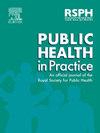Exploring network relations between healthcare access and utilisation in individuals with rare diseases
IF 1.9
Q2 PUBLIC, ENVIRONMENTAL & OCCUPATIONAL HEALTH
引用次数: 0
Abstract
Background
Rare diseases affect fewer than one in 2000 people and impact approximately 400 million individuals globally. High costs, uncoordinated care, and inadequate provider knowledge pose challenges to rare disease care. We aimed to examine the relationship between healthcare access and utilisation among rare disease patients in Switzerland.
Study design
A cross-sectional survey was conducted with 314 individuals with a rare disease.
Methods
Participants completed the Perception of Access to Healthcare Questionnaire (PAHQ) and provided data on healthcare utilisation (institutional and provider levels). Network analysis assessed nodes were based on expected influence (EI), predictability, and bridge centrality (BC).
Results
Four PAHQ subscales (acceptability, availability, adequacy, and awareness) exhibited higher EI and predictability. Conversely, accessibility and affordability of healthcare services had lower EI and predictability scores. In terms of healthcare utilisation, hospitals, private practices, general practictioners (GPs), mental health professionals, and emergency services demonstrated elevated EI and predictability. Specialists and holistic healthcare providers exhibited lower EI and predictability. Affordability, disease course, as well as hospital, and GP utilisation had elevated BC values and emerged as key connectors between access and utilisation.
Conclusion
This study illuminates the intricate dynamics of healthcare experiences for patients with rare diseases. This work validates network analysis as a valuable tool for examining healthcare systems. Findings can inform policies that address challenges faced by this vulnerable population, namely care integration for individuals with an unstable disease course.
探索罕见病患者医疗保健获取和利用之间的网络关系
背景:全球每2000人中只有不到1人受到传染性疾病的影响,影响到大约4亿人。高昂的费用、不协调的护理和提供者知识不足对罕见病护理构成挑战。我们的目的是研究瑞士罕见病患者的医疗保健获取和利用之间的关系。研究设计对314例罕见病患者进行了横断面调查。方法参与者填写医疗服务可及性认知问卷(PAHQ),并提供医疗服务利用情况(机构和提供者水平)数据。网络分析评估节点基于预期影响(EI)、可预测性和桥梁中心性(BC)。结果PAHQ四个分量表(可接受性、可获得性、充分性和知晓性)具有较高的EI和可预测性。相反,医疗服务的可及性和可负担性具有较低的EI和可预测性得分。在医疗保健利用方面,医院、私人诊所、全科医生(gp)、心理健康专业人员和急诊服务显示出较高的EI和可预测性。专家和整体医疗保健提供者表现出较低的EI和可预测性。可负担性、病程、医院和全科医生的利用提高了BC值,并成为获取和利用之间的关键联系。结论本研究揭示了罕见病患者医疗体验的复杂动态。这项工作验证了网络分析作为检查医疗保健系统的有价值的工具。研究结果可以为应对这一弱势群体面临的挑战的政策提供信息,即为病程不稳定的个人提供护理整合。
本文章由计算机程序翻译,如有差异,请以英文原文为准。
求助全文
约1分钟内获得全文
求助全文

 求助内容:
求助内容: 应助结果提醒方式:
应助结果提醒方式:


